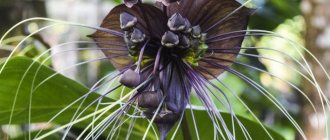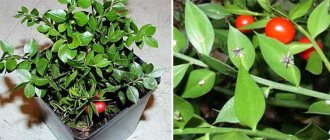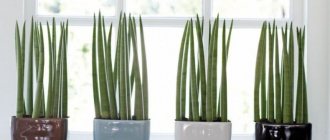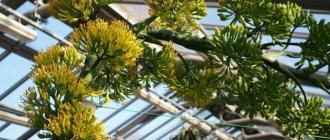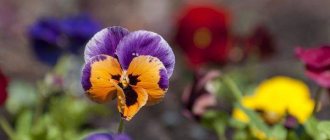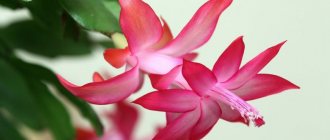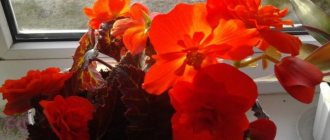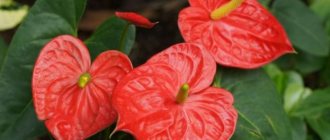Grevillea plants is quite large and is directly related to the Proteaceae family. It brings together approximately 370 plant species that can be found in nature in most cases in Australia. Only 5 species of this genus are found in other parts of the globe, namely on the islands of New Guinea, Sulawesi, and New Caledonia.
Plants of this genus are represented by evergreen creeping or erect shrubs, most of which are quite small in size (about half a meter). There are also quite large trees, the height of which can be more than 30 meters. The surface of the cylindrical shoots has a grayish and rather smooth bark. The alternate leaves are in most cases short-petioled. The shape of the foliage can vary significantly among different species. Tubular flowers can be either single-petaled or separate-petaled. Despite their small size, they form fairly large inflorescences in the form of racemes, as they have very long pistils.
General characteristics of Grevillea
The genus grevillea includes many species of evergreen plants belonging to the family Proteaceae. The most popular and easiest variety to grow is undoubtedly Grevillea rosmarinifolia, so named because its leaves are very similar to those of rosemary.
The grevillea plant has a fairly strong root system. The above-ground part, dense and slow-growing, consists of thin, branched and flexible branches covered with many small shiny dark green needle-like leaves.
At the tops of the stems, which are on average more than 1 meter high, very decorative flowers appear, special inflorescences collected in a raceme consisting of more than 100 flowers. The red, pink or variegated flowers have no petals and have an elongated calyx.
Judging by the photo of grevillea, the shrub looks very advantageous during the flowering period due to the combination of flaming inflorescences and dark green foliage.
Botanical description
Grevillea is a perennial evergreen plant of the Proteaceae family.
It grows in the form of a shrub or large tree (height up to 35 m), when grown indoors it is limited to a height of 2 m. The interest of flower growers in grevillea is caused by the structure of the leaves. Each leaf is elliptical in shape and simple. Alternately attached leaves make up a leaf plate up to 30 cm long. In general, it resembles a fern frond or thuja needles. The reverse side of the leaves is covered with fine hair, which gives the surface a silky feel. The leaves are soft to the touch and their color is deep green.
Grevillea blooming
How grevillea blooms photo
Grevillea flowers look like long narrow tubes. They gather in large spike-shaped or racemose inflorescences. Flowers can be white, but bright shades predominate (pink, orange, red). By the way, thanks to the sweet nectar, the flowers of certain types of grevillea were eaten by local residents.
Where is it found?
Most types of grevillea are common in the tropics of Australia, some can be found on the islands of New Guinea, Caledonia, Sulawesi, and the Moluccas. Focusing on tropical origin, it is necessary to create appropriate conditions for indoor cultivation: bright lighting, warmth, high humidity.
Grevillea is a flowering plant, but blooms extremely rarely at home. Most often, grevillea is grown as a decorative foliage tapeworm in bright, cool rooms.
The first description of grevillea dates back to 1809, and the name of the plant was given in honor of Charles Greville (English botanist, member of the Royal Society).
Varieties and types of grevillea
The genus Grevillea is one of the most interesting members of the Proteaceae family, with about 200 cultivated species, mainly due to its very showy flowering.
The genus is divided into two parts: one called Anadenia, which includes species that usually have pinnate or serrated leaves (Grevillea robusta belongs to this group), the other is Manglesia, which is characterized by alternating entire leaves. or less needle-like (the species Grevillea juniperina belongs to this group).
Grevillea robusta
Grevillea robusta - this species belongs to the Anadenia section, the largest representative. In optimal conditions it can reach 30 meters in height.
Robusta grevillea can be found in parks and on the avenues of Sochi, Stavropol and Krasnodar Territories. This is a very popular variety due to the beauty of its leaves of various shapes, often feathery with deep lobes, reminiscent in appearance of some ferns.
Robusta Gravillea is used in Sri Lanka as shade for tea plantations. In temperate regions, this species is used exclusively for ornamental purposes, both as an indoor foliage plant in northern regions and outdoors in the subtropical zone.
Grevillea Banksi
Grevillea Banksi - This species is suitable for temperate climates and gardens by the sea. It is a large bush with a very elegant appearance that can take the form of a small tree. It has pinnate leaves with very thin and elongated blades.
The flowers form long terminal spikes with red stigmas and a yellow tip. Perennial specimens reach a height of 10 meters and a width of 5 meters.
Grevillea stenomera
Grevillea stenomera is a beautiful shrub with silvery foliage that reaches a height of about 2 meters, suitable for mild climates. It is characterized by bright red or dark pink inflorescences, from which long pistils and stamens protrude, turning green, and which create a special chromatic contrast.
The species lanigera has a compact, dwarf and drooping habit, sometimes with spreading branches.
It is characterized by small leaves densely packed on stiff and felty branches, the leaves have curled edges and form a dense mass of leaves dotted with red or pink flowers, with contrasts between red and cream or green and cream.
Grevillea lanigera
Grevillea lanigera has good winter hardiness. Recommended varieties are Grevillea lanigera 'Mount Tamboritha', 'Compacta' and 'Clearview John'.
Grevillea thelemanniana is small in size and reaches a maximum height of 1.80 meters. It is characterized by red flowers, collected in dense, perfectly symmetrical panicles, and branches covered with very narrow leaves, sometimes feathery. Over the years it becomes more and more tree-like.
Grevillea juniper
Grevillea juniper is the most common and popular in our country. This is a dense bush of a round shape with lanceolate-linear leaves of a prickly green color.
Among the shrub species, it is undoubtedly the most common, has a rounded shape and bright green, dense and tough foliage. It produces beautiful red, orange or yellow blooms that begin in late spring to mid-summer.
Grevillea juniper inflorescences consist of graceful hanging racemes up to 6 centimeters long.
Its height can reach 2 meters. For this reason, it is widely used to create small hedges with high ornamental value, especially for coastal cultivation. Juniper is distinguished by its exceptional ease of cultivation, richness and early flowering, as well as remarkable frost resistance.
Features of transplantation at home
Until the age of three years, grevillea must be replanted annually. Replant adult plants approximately once every 3-4 years; when grown in a tub, as the tub rots. For adult plants, it is necessary to change the top layer of the substrate annually (carefully remove it to a depth of 5 cm). Replant or replace the substrate in early spring before growth begins.
Each time you replant, slightly increase the diameter of the container. The pot should not be deep; in such conditions grevillea does not develop well.
Be sure to lay a good drainage layer at the bottom of the container, consisting of expanded clay, pebbles, clay shards, and pieces of polystyrene foam. The soil requires loose, nutritious, neutral or slightly acidic reaction. It can be prepared on the basis of 2 parts of coniferous soil, with the addition of 1 part of leaf soil, peat and ½ part of coarse sand, also add brick chips for looseness.
Once the drainage is in place, add a layer of fresh soil into the container. Carefully remove the grevillea from the previous pot and lightly shake off the soil from the roots. If rot is detected, it is necessary to cut off the affected areas and treat the cut areas with a fungicide. After this, place the grevillea in the center of the new container, add the substrate, then press it with your palms on the surface around the stem. Water it a little and move it to a slightly shaded place for a couple of days to adapt.
Growing Grevillea
The plant loves sunny or semi-shaded places, protected from the wind. Mature plants tolerate winter temperatures below 0°C very well.
All plants of this botanical species love slightly acidic, loose, soft and well-drained soils. This plant is very resistant to fungal diseases and is rarely affected by parasites such as aphids and other insects.
Grevillea is propagated by seeds in spring or cuttings in summer. The most common technique is cuttings: in the spring, semi-woody cuttings about 10 cm long are taken from the side shoots.
Rooted cuttings are planted in a mixture consisting of two parts universal soil and one part sand, which should be regularly watered and kept moist. Once established, they are then transplanted into individual containers or in the ground and grown as mature plants.
Grevillea tolerates cold well, so indoor plants grown in pots must be protected from frost and not left in unheated rooms. Young plants grown directly in the ground should be protected with breathable materials.
Pests
More than others, spider mites annoy the plant. The risk of infection increases many times when kept in too warm conditions or excessively dry air. You can often get rid of the problem by simply adjusting the conditions and frequent spraying.
In home and garden interiors, grevillea always plays the role of a soloist; it is never placed in plant groups. This is due not only to its bright individual appearance, but also to the requirements for spacious single growth.
Watering and fertilizing
Although it tolerates periods of prolonged drought very well, it is recommended to water the shrub regularly during vegetative regeneration and in the summer and only when the soil is completely dry.
In the fall, dig a large amount of aged manure or a handful of slow-release granular fertilizer at the base of the bush.
Reproduction - step by step instructions
The life form of grevillea is an evergreen bush or tree with many fast-growing shoots and requires periodic pruning. The plant is viable and easily propagated by cuttings or seeds.
Cuttings
To propagate an ornamental bush, you need to choose strong, woody shoot tips. The most suitable time for this procedure will be August. To get a healthy plant with exotic leaves, you need to correctly divide the shoot into cuttings.
- The most suitable for cuttings is the part of the stem that has begun to become covered with a woody layer;
- Using a sharp knife, cut off the selected shoot, the length of which is 15-20 cm;
- It is necessary to cut off the upper green part of the shoot;
- Divide the remaining cutting into parts so that at least two nodes (dormant buds) remain on each.
- It is better to remove the green part of the leaves, since a lot of moisture evaporates through the leaf blade.
- The cutting responds gratefully to the treatment of the lower part with root.
- The shoot, treated with a growth stimulator, is planted for rooting in a container filled with a mixture of turf soil and river sand and covered with a transparent jar or bottle to create greenhouse conditions.
REFERENCE. A node is the place on the cutting from which a leaf grows, and the distance between the nodes is called the internode.
Seeds
The seeds of this luxurious plant with lacy spreading leaves look like large brown grains. They quickly lose their viability, so you need to carefully monitor expiration dates and use only fresh material.
- Grevillea seeds can be planted in mid-February in a shallow container.
- The soil should consist of a mixture of turf and leaf soil with river sand. Seeds should be sown to a depth of 1 cm.
- To ensure better germination, water the sown grains with warm water.
- To germinate grevillea seeds, you need to choose the warmest place in the room and place the bowls there.
- After the sprouts appear, the young shoots need to be moved to a well-lit, warm place.
- After the second leaf appears, the sprouts can be planted in small pots with a diameter of 10 cm.
Photo of Grevillea houseplant
Possible problems
When growing grevillea indoors, you need to remember that if it is poorly cared for or has unsuitable conditions for growth, problems may arise with it. For example:
- Slow growth. Either the wrong substrate was used for planting, or the bush experiences an acute lack of nutrients. In this case, they begin to add fertilizer to the substrate twice a month, and in the spring, be sure to replant the flower in a fresh soil mixture.
- All the leaves have fallen off. This happens due to too little watering or when the lump of earth in the pot is too dry. Immerse the flower in a container of water at room temperature and remove it after half an hour.
- The foliage turns yellow. This can happen if the bush is kept warm in winter rather than in a cool place.
- Spider mite. It prefers warmth and low humidity. To exterminate the tick, the bush is washed under a warm shower and then systematically moistened with clean water from a spray bottle.
- Whiteflies. Such small pests, similar to whitish moths, are very dangerous for grevillea. To get rid of them, the plant is repeatedly treated with an insecticide solution.
Wonders of Botany: Crystal Flower (Grey's Twofoil)
We Russians are accustomed to the fact that exotic plants grow somewhere far away, “at the ends of the Earth,” in Africa, on the islands of the Indian Ocean, in North America. But amazing, simply fantastic plants can be found in various regions of our country. For example, in the Far East there grows a very unusual plant - Gray's bifolia, which is also known as the “crystal flower”.
Description of the plant
Bifolia are perennial herbaceous plants that belong to the Barberry family. This is a fairly small genus. It includes only three types:
- North American – corymbose bifolia;
- “resident” of East Asia - Chinese bifoil;
- Far Eastern - Gray's bifolia.
It is the latter variety that grows on the territory of our country: on the islands of the Kuril chain (Iturup, Kunashir), on Sakhalin. It can also be found in China and Japan (on the islands of Honshu and Hokkaido).
It grows in birch or coniferous moist forests and is very rarely found in the wild. Gray's bifoil is listed in the Red Book. Its flowering lasts only a few weeks (3-4), but its beautiful appearance makes it decorative throughout the entire growing season. Largely due to this, Russian gardeners, gardeners, summer residents, and lovers of exotic plants have recently begun to become interested in them.
The Latin name for the flower is Diphylleia. It is formed from a combination of two Greek words (dio, which means two, and phyllon, translated as leaf) and is explained by the structural features of the plant: on two long petioles (up to 20 cm) there are two large shield-shaped leaves, reaching a width of 50 cm and having palmate veins (from 7 to 9 pieces). There is a slight edge on the bottom of the leaf blade. The leaves are arranged in the same order. Usually the first leaf is larger than the second.
The plant has a very tangled thick rhizome, which is located horizontally under the surface of the earth at a depth of no more than 3-6 centimeters. If you look closely, you can see small scars on the surface of the root of an adult plant. These are traces of outdated and dead shoots. By counting their number, you can determine the age of the bifoil.
In the second half of May - early June, the plant throws out an arrow, the height of which can reach 1.5-2 meters. At the very top of the peduncle there is a thyroid inflorescence with a diameter of 6-8 cm, consisting of 8-12 buds, sometimes up to 30. Over time, they turn into small white flowers with 6 sepals, 6 flat petals and 6 bright orange stamens. The flowers are quite small, the diameter of each does not exceed 2-2.5 cm. After opening, they emit a pleasant aroma, similar to the smell of rose hips.
After flowering is completed, small berries form in place of the flowers. In July-August they ripen, acquiring a dark blue, slightly bluish color. The juicy berries look like grapes. Inside each there are 6-9 pear-shaped seeds. in autumn the above-ground part dies off completely, leaving behind another scar on the rhizome.
The secret of the “crystal flower”
Gray's bifoil is decorative throughout the growing season. Not only its leaves and flowers look original, but also its spectacular blue berries, reminiscent of grapes. Therefore, a plant planted in the garden will decorate it all summer. However, in the wild, in a coniferous forest, you can pass by and not notice it, but it has its own secret, thanks to which it is sometimes called the “crystal flower.” In America it is known as Umbrella-leaf. In some countries it is called Skeleton Flower.
What is so surprising about this seemingly completely ordinary flower? When water (rain or regular water from a garden watering can) falls on the petals of the inflorescence, they lose their white color and become absolutely transparent like glass, so transparent that you can see green leaves through them. As the water dries, the petals return to milky white.
The nature of this amazing phenomenon has not yet been solved by either biologists, physicists, or chemists. There are several assumptions; it is impossible to say how fair they are. According to one version, a chemical reaction occurs between the surface of the leaves and water, which leads to the thinning of the petals so much that they become like the thinnest plastic film. Another theory suggests the electrical nature of this process.
In your own garden, you can see the unusual effect yourself or surprise your neighbors with it almost at any time during the flowering period of Gray's bifoil. To do this, just lightly spray the petals from a spray bottle or plastic bottle. If weather conditions permit (sufficient level of illumination), then it is quite possible to film what is happening on a video camera, smartphone, and then post it for public viewing on the Internet.
Growing in the garden
Diphylea is a wild plant that has not yet been cultivated by humans. But, despite this, it can be grown in your own garden, on your personal plot, used to decorate flower beds, front gardens, and used in landscape design.
Caring for bifolia
In the wild, it chooses moist places, sheltered from bright sunlight, therefore, in the garden for its cultivation, places should be allocated in the shade, partial shade, in the garden among the trees, away from scorching rays. Despite the fact that the plant has fairly large leaves, they are very fragile and strong gusts of wind can easily damage them. Therefore, areas protected from wind and drafts should be allocated for planting bifoil.
The flower has recently begun to be cultivated in gardens, so it grows well even without additional fertilizer, especially on fertile, loose soils. The only thing it needs is regular watering. It is recommended to do it every other day. However, you can reduce the frequency of watering to once a week by pouring at least a bucket of water under each root. To do this, the ground under the bushes is mulched with straw, sawdust, and peat, which will reduce the evaporation of moisture from the soil surface.
The plant is practically not affected by insect pests and diseases. But for preventive purposes, bifoil must be treated with special pest control agents 1-2 times during the growing season. Sometimes young plantings are “attacked” by snails and slugs. They are collected by hand, and to prevent new attacks, the ground in the hole and around the plant is sprinkled with sharp expanded clay.
